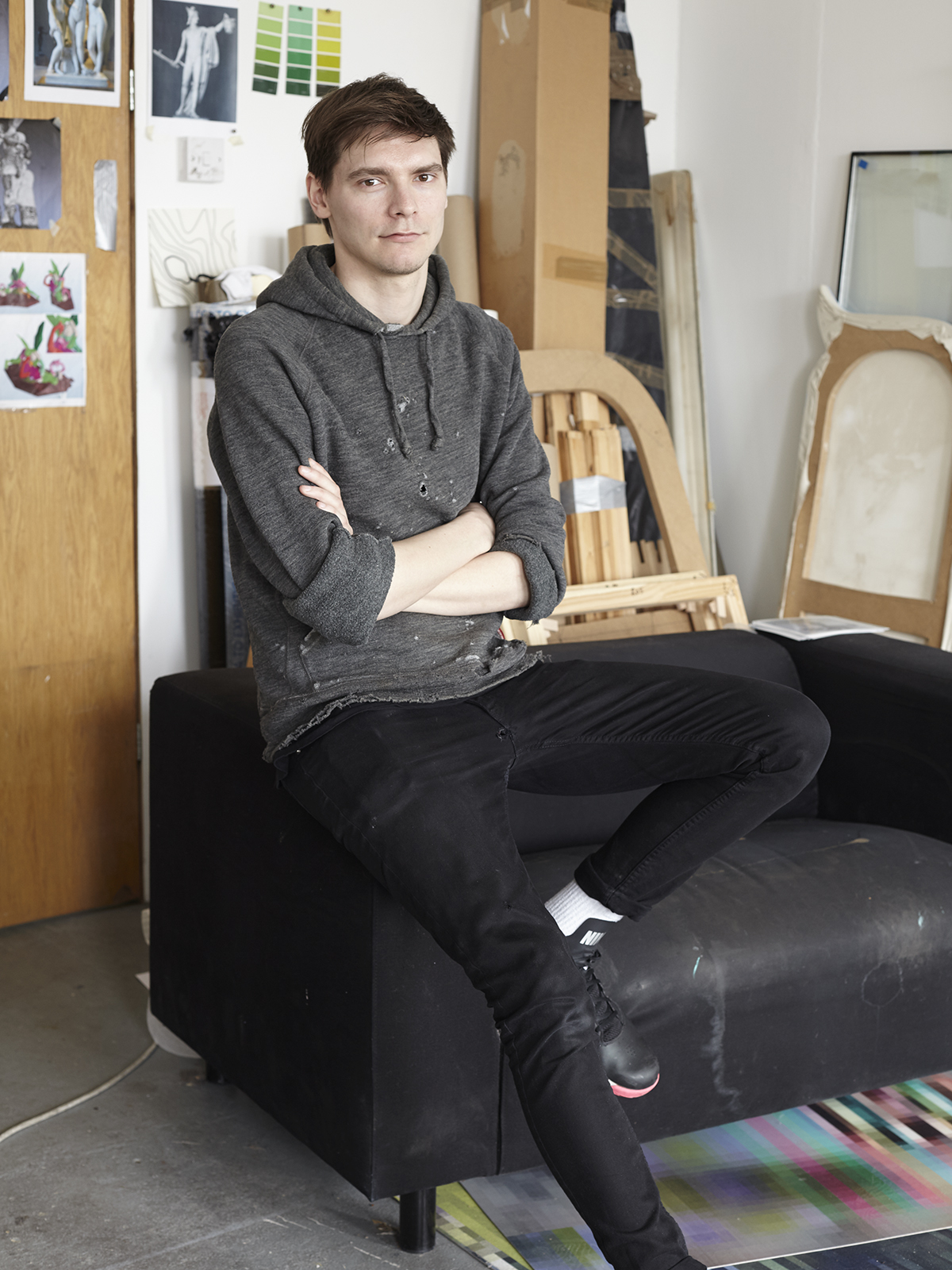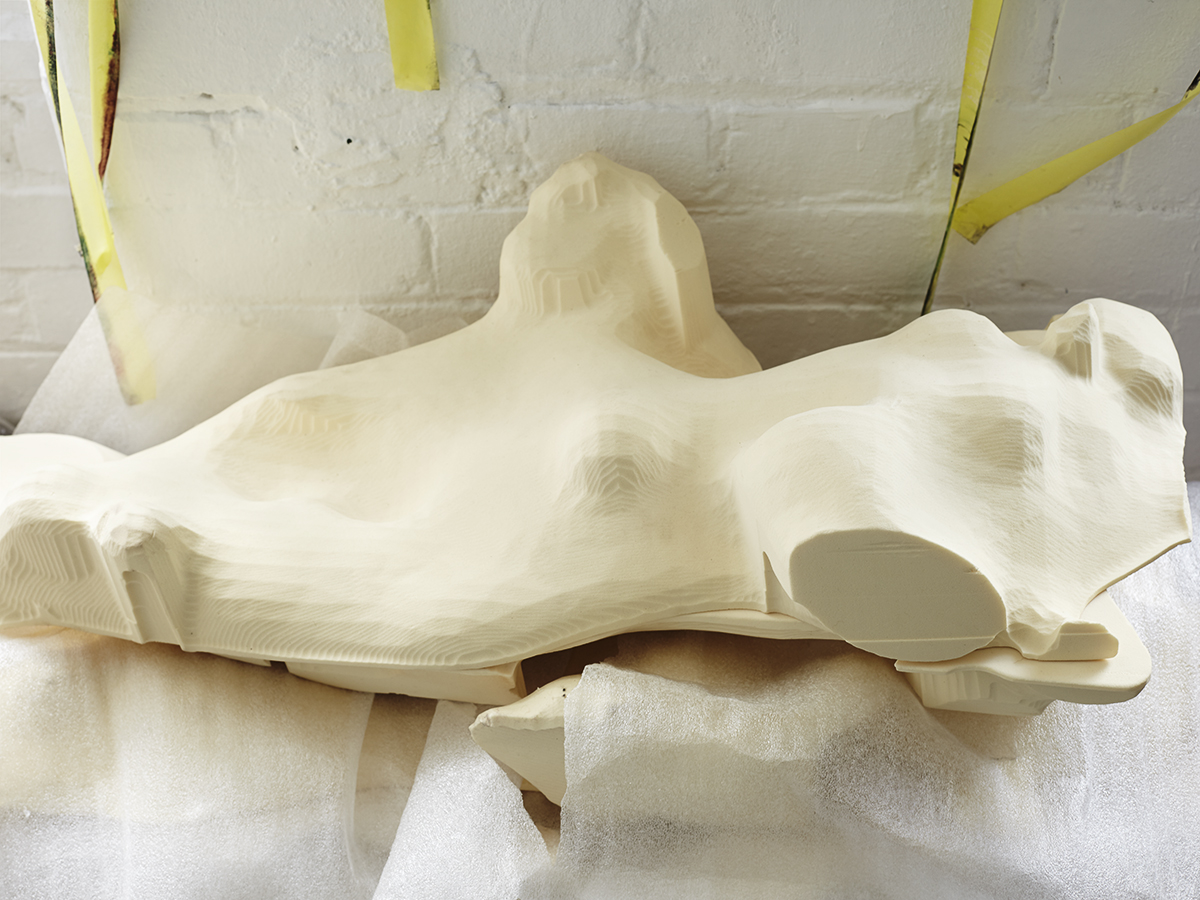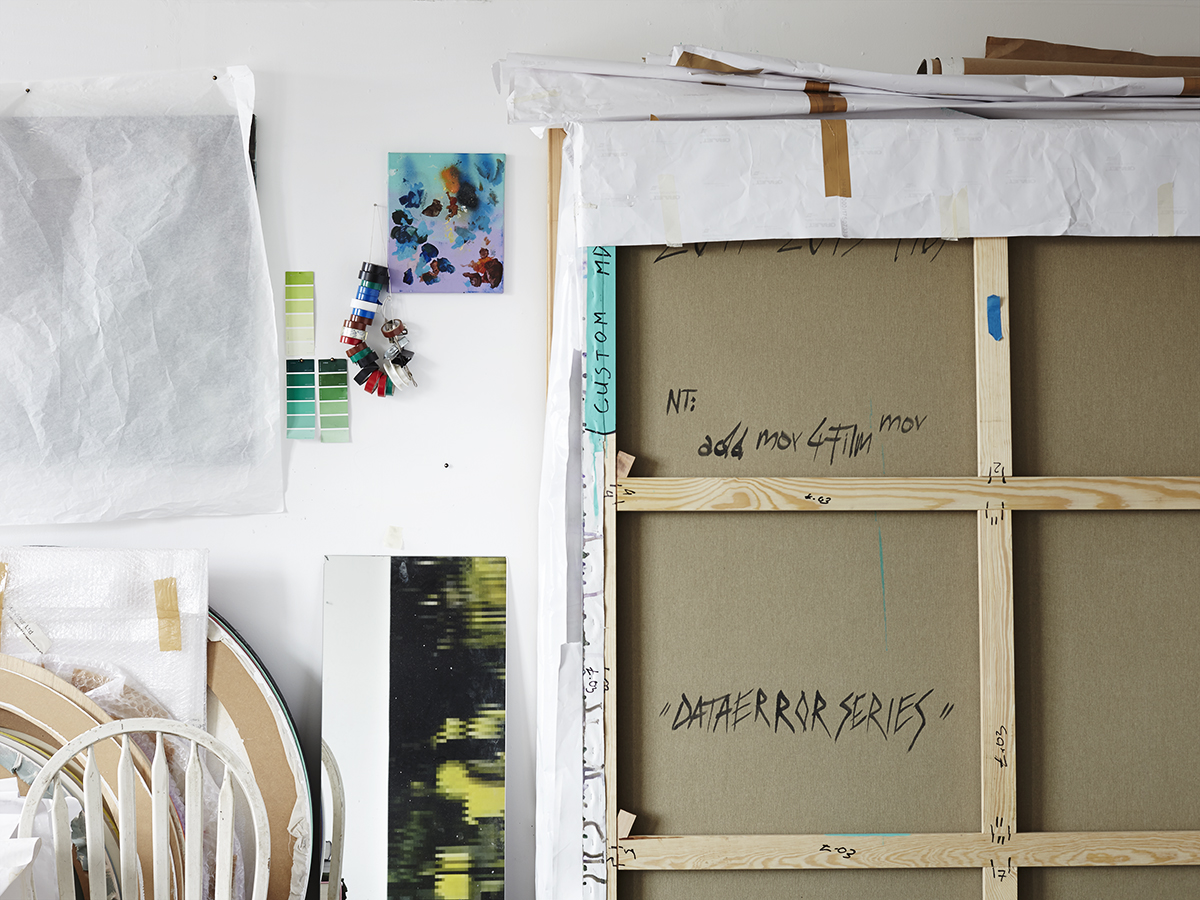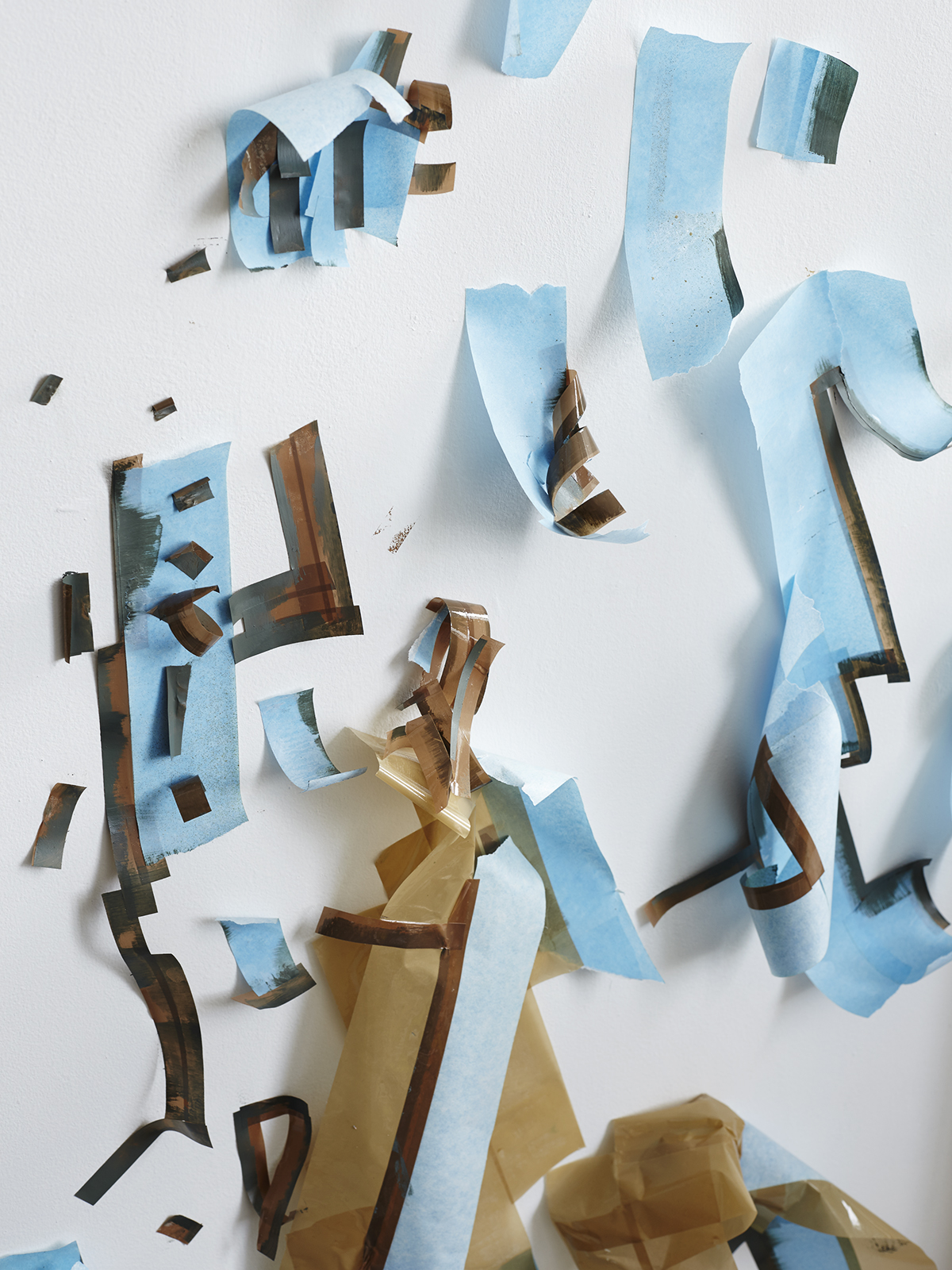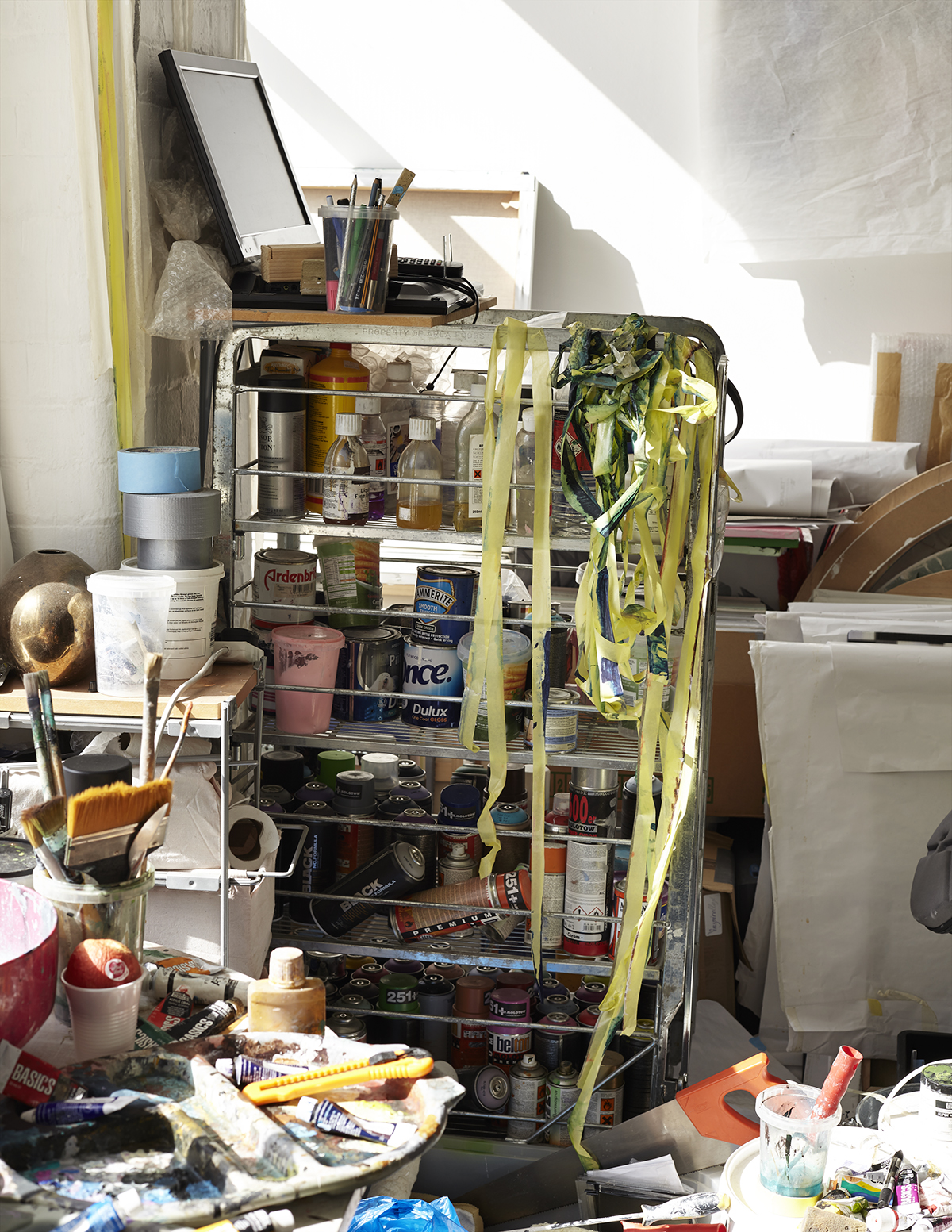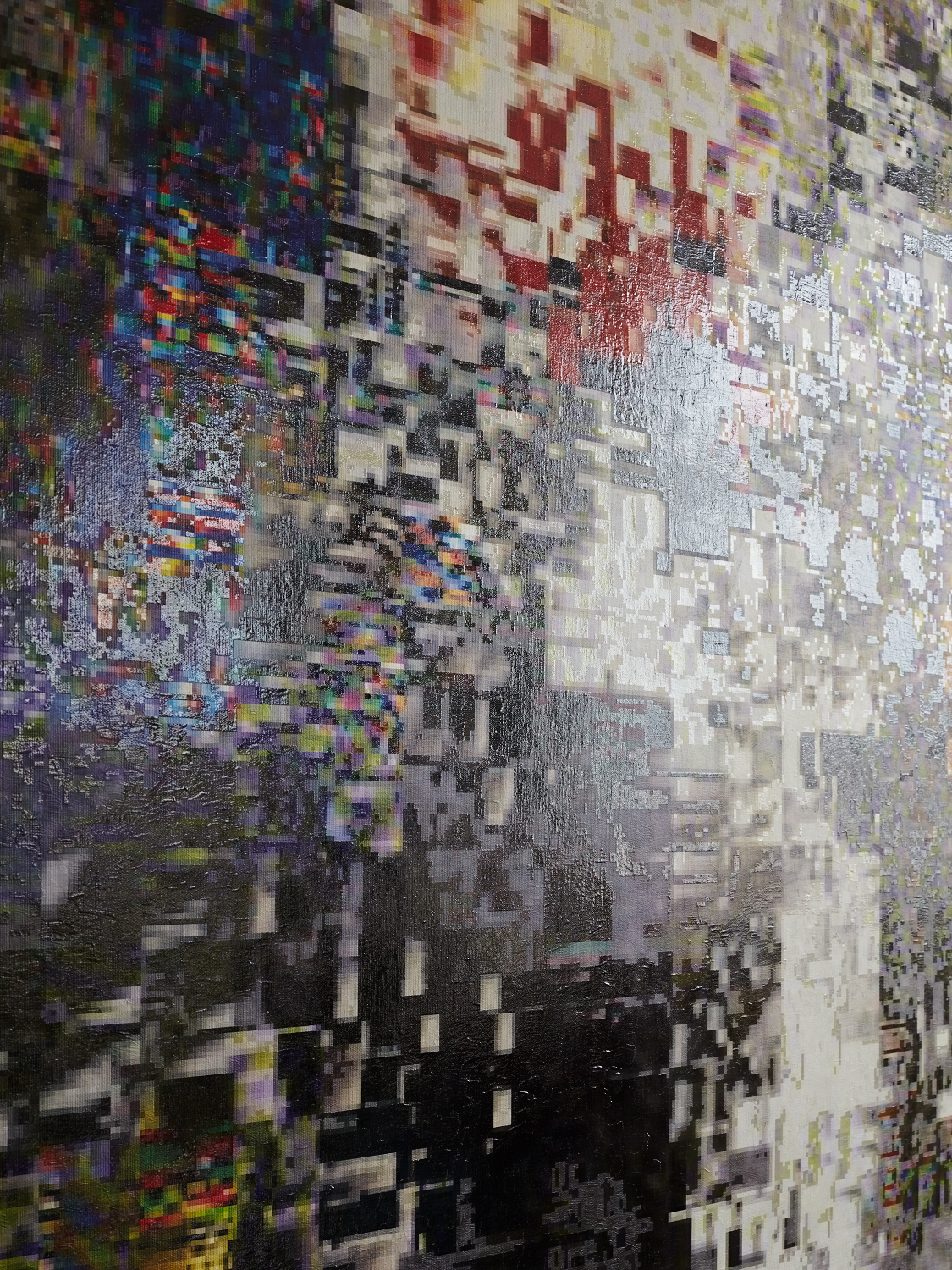
How are these pieces made?
I call them data error paintings, and I create them by corrupting videos or images. I send the video or image between software or devices—so between two phones, or laptops or stream it online—and I record the process. As it happens, a glitch or an error will start to occur. Then I do it again, and again, and again. After the moment when I get something interesting, I select the area that I’m most interested in—for the colour, the composition, whatever else—when I feel like it’s working for me, and then I make a painting from it. I take a screenshot and then work with five to seven layers of paint, with a projector and lots of taping. Five of the seven layers usually are handmade, and for two layers I will work with the machine as well. I start manually with a stencil, with the layers of white and black. They’re a mixture of loads of different techniques.
How do you select the source material? Is the original image important?
It is conceptually important yes. I like the idea of nature and technology being together or against one another. For centuries humans have been separating from nature, but we are getting to an age where we are taking directly from nature; so we’re looking at solar panels, and even some materials are designed in a way that they open up in the same way leaves might open up. I like this tension with the concept. The show at Ron Mandos is related to the issue of global warming and climate change, so the source material was really important for me here. I looked for two different sources—the video footage related to the ice caps, melting ice and the scientific investigation about what is happening with that, and the other thing that is very crucial for global warming which is weather changes around the world. I removed the human presence, so it’s not like a catastrophe, I wanted to keep it very nature based. In the show I don’t talk about all aspects of global warming, as that would be impossible, but I talk about the information side. So the corruption of the information about global warming and the way it’s being shown. I talked to scientists, philosophers, writers, my friends who are artists, and specialists in the global market in the last eight months of my research. What I found out is that there is a big confusion about global warming. The main media coverage is that humans are responsible and this is the angle we are taking, but if you talk to scientists they are actually not so sure that this is the case. So this was very interesting for me, and I spoke to psychologists who explained there is this need every few years for an apocalyptic vision. The very interesting angle is that humans like to be in charge of our reality, of the world we are living in. So taking the position that actually we screwed up and are responsible is putting us in power. Otherwise, if we aren’t repressible, there is a loss of power. There’s also a drive there towards spending on the new technologies and cars. I don’t say it’s true, good or bad, but I’m more interested in bringing awareness and raising the questions. I like to question the information.
One of the first video paintings I ever did was of a newsreader, and it’s the most vivid example of what the work’s about. Because I travel a lot and I was born in Czech, and my parents are from Russia and Poland, and now I’m living here [London], what I notice is that in every single country, information about say, Ukraine, is presented very differently. So there is this margin of corruption to the information which I like to question. I don’t really change the footage, I just set it out and hunt for an error to occur. This is the process, and then because I’m a painter, of course I like to paint it.
Where would you say it came from? Did you have an interest in these kind of glitches before you began painting, or were you experimenting first with a painting style that led you to this?
It’s interesting actually, before my studies I was very focused in this subject, I used to do this kind of art, and then I went and studied for several years (7 in total) and made completely different art to what I’m making here. It was also about deformation, and it was painting and video too, but they were figurative and human. As soon as I finished my studies I came back to this style. So in a way, I went for my studies, I learnt technique, I did something aesthetically very different and then came back to the beginning of my roots. This current series has roots maybe even 12 years ago.
I read in your statement that you want to explore the hand of the artist, against the idea of technology that is very much more controlled. Do you find the control of the process you use very satisfying because it is so controlled, or is there a tussle going on?
Do you know, the process is very complex. I start to paint on the computer, I’m looking for the concept but I’m also looking for the colour. I’m looking at the screen for hours, and corrupting the footage. I’m not going into the coding and corrupting something purposefully, because that would be conceptually weaker for me. I still want a figurative image with the error inside so I can emphasise it or set the conditions for it to pop out. So it’s like painting, looking all the time for the settings, adding new footage. Also in terms of art history it’s very interesting; if you imagine that in the painting you are viewing the footage from many angles, and it emerges into one, it’s almost like Cubism, painting a face where you can see it from there, there and there, and then you merge it all together. The beginning of the process is very creative but it’s also very independent. I curate, I make the decisions, I look for the composition, for the colour. I decide how I want to have it, but then there is also this dependency on the machine as well. Creativity and art is the last island that we expect machines to stay out of, so it’s interesting for me to use machines in close collaboration. It’s a long process to get all the details, but I find it very relaxing as well.
I find it interesting that there’s quite a traditional influence on the work, when you did the Instagram takeover on Elephant you posted Caspar David Friedrich’s Wanderer Above the Sea of Fog…
I studied art history so I know a lot about it, and for me it is always inspiring. I think [Friedrich was] standing in the same state in culture and mentality during the Romantic era as we are now. People were standing on an edge, scared of the industrial revolution but also of nature. They were fighting lots of forces in nature, and I think we’re standing in the same moment here, wondering about the changes that are happening. Conceptually I feel this connection. Even if my paintings are very technological, there is this romanticism in them; looking into the future and reflecting on that. Especially with this exhibition I felt this mental state.
Can you tell me a bit about the floor that is showing at 2 C above acCLI M8 X?
I have wanted to make this for a long time, but you need the right space and the right gallery. I’m very happy with the installation. It’s raised on a platform by about 10cm and it connects with the title of the exhibition. A few years ago scientists drew a line, said if global temperatures were going to cross it by 2 celsius, we were going to be screwed! This actually happened a few months ago and no one is talking about it or saying anything. I think about art very holistically, and I wanted the viewer to be in the middle of this situation, with the paintings and the issues I’m addressing.
Would you say you’re inquisitive about technology and what it can do, or are you yourself invested in some of the more environmental questions that come up?
You know this is a very good point. I think naturally there is this kind of tendency in the work, but I don’t really criticise or say: this is bad, or this is good. I’m much more interested in bringing it out to have a conversation about it and understand the world we are living in so that you can navigate that world, or create something out of it. I can see that it could be critical about the information and how it is corrupted, but I’m much more interested in asking the questions than giving a verdict.
You spoke earlier about that apocalyptic belief that every generation has, where they feel they’re living in the end times. But as you also said technology is actually getting closer to nature in many ways.
I think it’s also a question about the ego, the human role and the artist role. Maybe instead of ruling the world we should be collaborating more, and I think this is the new approach, it’s a little bit of the new age as well. Maybe sometimes it connects with some conspiracy theories, but it’s the time we’re living in and I touch many different issues.
Do you study a lot of these issues a lot yourself, or do you mainly go to experts when you’re building a series?
I do a lot of studying myself, and I love nature, it’s something that interests me and I want to know more. So I put into my work what I find out. It’s my interest, so it’s very personal in a way but it’s also something I do all the time. This research is going through my life. I think as an artist this is the thing; I go to sleep, I dream about something, I note it down. It’s not even like a full time job, it’s my life. Sometimes it can be stressful as I constantly think about this, but then, that’s what you do. I couldn’t do anything else and I’m very lucky that I can live off this.
‘2°C above acCLI-M8 X’ is showing at Galerie Ron Mandos until 14 May. Photographs © Tim Smyth.
